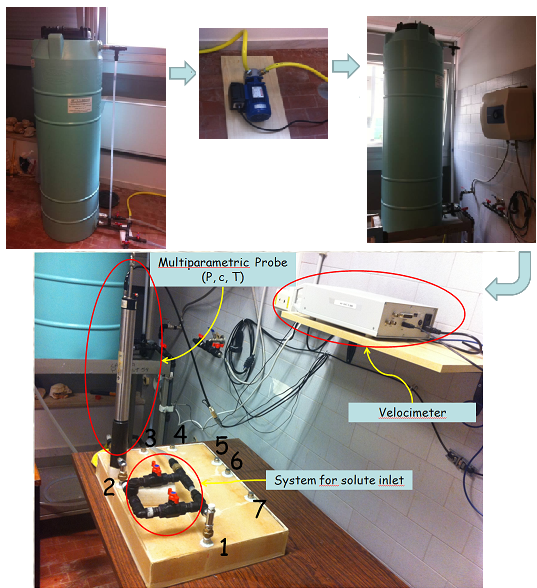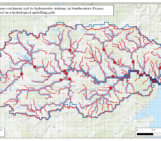This week in GeoTalk, we’re talking to Claudia Cherubini, a research professor from La Salle Beauvais Polytechnic Institute. Claudia shares her work in hydrogeological modelling and delves into how such models can be used in water management…
Could you introduce yourself and tell us a little about what you’re currently working on?
I am an environmental engineer with a PhD in hydrogeology. After more than four years of post-doctoral activity, I finally got a position as associate professor at LaSalle Beauvais Polytechnic Institute, one of the most reputable schools for engineering geologists in France.
My field of research involves characterising flow and transport phenomena in heterogeneous aquifers. My research interests include also advanced geostatistical methods to model complex spatial patterns of contaminants and quantify risk assessment – something I concentrated on when working as a consultant for the Italian Ministry of Environment and the Apulia Region (southeastern Italy).

Meet Claudia! (Credit: Claudia Cherubini)
During EGU 2012, you received a Division Outstanding Young Scientists Award for your work on hydrogeological models and how they can be used in resource management. Could you tell us a bit more about your research in this area?
Before coming to France, most of my research dealt with the hydrogeology of the fractured limestone aquifer in Apulia and, in particular, with water management in coastal aquifers.
The key study concerning this prize is published in Natural Hazards and Earth System Sciences. Together with my Italian colleague Nicola Pastore, I combined two models – one describing density-driven flow and another describing fault hydrogeology – to find out more about the aquifer system in southern Italy. The coupled models let us work out how this complex aquifer could be exploited as well as determine its vulnerability to seawater intrusion. Vulnerability assessments like these are needed for sustainable planning, both in terms of picking well locations and setting pumping rates.
Fractured aquifers are key water sources for many people around the world, how do your findings relate to sustainable water use in these areas?
Most of my research deals with modeling groundwater flow and contaminant transport in fractured aquifers. Detailed geological reconstructions are used in hydrodynamic modelling to help interpret flow dynamics and the way contaminants are transported. Hydrogeological modelling is extremely important to optimise water extraction in fractured aquifers, to pin down pollution sources or predict the fate of a contaminant. All of these help decide how to manage areas that have been affected by a pollutant. Due to the complexity of fractured rock aquifers, they are often oversimplified. My research aims to apply discrete models to better describe flow and transport dynamics in these aquifers.
How does knowing more about groundwater help scientists understand the impacts of polluted sites on the surrounding environment?
In fractured-rock aquifers, the fracture’s orientation may cause the contaminant plume to be transported in a direction that diverges from the regional hydraulic gradient. Being able to characterise the dominant fractures in the system is extremely useful for aquifer cleanup.
How can hydrogeologists set up something close to what we might find in nature in the lab?
In fracture formations, multiple scales of heterogeneity may exist and there is the need to characterise them at the core, bench and field scale. There is some degree of skepticism about how representative physical models are of phenomena occurring in field conditions though. Laboratory experiments have the advantage of improving our understanding of physical mechanisms under relatively well-controlled conditions, which is not exactly the case in the field.
Do you prefer fieldwork or fixing up a laboratory experiment?
I would say probably the second. Dealing with lab experiments concerning fractured media is a matter of creativity and innovation, as there is still a lot to do in this research area.
However, here at LaSalle Beauvais we have set up a hydrogeological platform with an experimental site with 18 boreholes up to 110 m deep, each equipped with piezometers – instruments used to measure liquid pressure, so future directions are oriented towards fieldwork.
What do you enjoy about working in science?
I always felt at ease in science and I have always enjoyed doing research everywhere I go. I currently speak English, German, Spanish, French and obviously Italian (my native language). I spent some research periods abroad: during my PhD at The University of Göttingen Geosciences Centre, and during my post doc at Lawrence Berkeley National Laboratory and at United States Geological Survey in California too.
Finally, what are your research plans for the future?
I work in Picardy (north of France), a region characterised by a fissured chalk aquifer, where the unsaturated zone has been poorly investigated. I am setting up a study with the notable scientist John Nimmo of the USGS, aiming to investigate preferential flow dynamics and their role in recharge within this chalk aquifer.
And I have an Italian PhD student to supervise! She will come here to do laboratory and field experiments on the platform. We also plan to integrate our network into the French H+ observatory, a database for data from a network of highly heterogeneous hydrogeological sites.
Find out more about Claudia’s work on fractured aquifers…
Cherubini, C. and Pastore, N.: Critical stress scenarios for a coastal aquifer in southeastern Italy, Nat. Hazards Earth Syst. Sci., 11, 1381-1393, 2011.
Cherubini, C., Giasi, C. I., and Pastore, N.: On the reliability of analytical models to predict solute transport in a fracture network, Hydrol. Earth Syst. Sci. Discuss., 10, 2013. (currently under open review)
Cherubini, C.: A modeling approach for the study of contamination in a fractured aquifer. Geotechnical and Geological Engineering, 26, 519-533, 2008.
Cherubini, C., Giasi, C. I., Pastore, N.: Evidence of non-darcy flow and non-fickian transport in fractured media at laboratory scale. Hydrol. Earth Syst. Sci., 17, 2599–2611, 2013.
Cherubini, C, Giasi, C. I., and Pastore, N.: Bench scale laboratory tests to analyze non-linear flow in fractured media. Hydrol. Earth Syst. Sci., 16, 2511-2522, 2012.
If you’d like to suggest a scientist for an interview, please contact Sara Mynott.




Pingback: GeoLog | Earth Science Week 2020: Earth Materials in Our Lives - an A-Z! - GeoLog